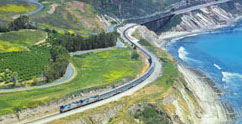 Air travel emits about 20 times more CO2e than train travel. Be green and travel stress-free by taking the train instead of flying.
Air travel emits about 20 times more CO2e than train travel. Be green and travel stress-free by taking the train instead of flying.
Air travel gets you from point A to B relatively quickly but it has a huge carbon footprint and you often arrive at your destination tired, stiff, cranky, parched, and stressed out. You need time to recover from the flight before you can begin to enjoy your vacation.
Taking the train is by far a greener option involves minimal hassle, and allows you time and space to decompress from work and enjoy the journey. Your vacation can begin as soon as you board the train.
In this 2-part post, our recent family vacation to Mount Saint Helens, WA via Amtrak’s Coast Starlight train will serve to illustrate the green aspects of train travel and its positive impact on travelers.
Four major factors to consider when deciding to travel by plane or train are:
- Carbon footprint
- Time
- Cost
- Personal wellbeing
Carbon Footprint
Air Travel
If we had traveled by air, our family of four would have flown from San Luis Obispo, CA to Phoenix, AZ where would have changed planes and then flown to Portland, OR.
Round trip, we would have flown about 3,000 miles resulting in 0.77 metric tons of CO2e emissions per person (including radiative forcing), which equates to 3.08 metric tons of CO2e for the family. 1, 2
Train Travel
We boarded the Amtrak Coast Starlight in Paso Robles, CA and disembarked in Portland, OR.
Round trip, we traveled 1,864 miles resulting in 0.04 metric tons of CO2e emissions per person, which equates to 0.16 metric tons of CO2e for the family. 2, 3
Comparison
The difference between air and train travel for our trip was significant at 2.92 metric tons of CO2e. To put that figure in perspective, one could drive an average American passenger car for over 7 months for the same emissions saved by taking the train. 4
Imagine the amount of pollution we could keep out of the atmosphere if we all opted to take the train instead of fly, at least some of the time.
Time
Although flying is often the quickest way to travel, especially for longer distances, when you take pre-boarding time into account, riding the train for shorter distances can be just as fast as or faster than flying.
 Both airplanes and trains are subject to delays due to weather, equipment problems, and airport or track congestion.
Both airplanes and trains are subject to delays due to weather, equipment problems, and airport or track congestion.
If we had flown, our total travel time including pre-boarding, the flight, and retrieving our checked luggage, would have been about 10 hours (if all went well).
The overnight trip on the Coast Starlight took about 24 hours.
Cost
The cost for both air and train travel can vary widely depending on where you live, where you are going when you are going, how far in advance you buy your ticket, and travel class (e.g. coach, business, first).
Tickets
 For our trip, if we had booked well in advance, coach airfare would have been about 2 ½ times the cost of a coach seat on the train.
For our trip, if we had booked well in advance, coach airfare would have been about 2 ½ times the cost of a coach seat on the train.
For the overnight trip, we opted for two sleeping compartments which included meals in the dining car. Our train fare was comparable to airfare.
Parking
Parking at our tiny airport would have cost us an additional $8 a day and require dragging our luggage uphill at least ¼ mile to the terminal.
We parked right next to the Amtrak station at no additional charge.
Baggage Fees
Although some airlines do not charge extra for checked bags, many airlines charge $25 or more per bag. If we had flown, we would have racked up an additional $250 in baggage fees.
Amtrak allows passengers to bring luggage on the train and offers checked baggage, all at no additional cost. We stowed our luggage downstairs in the sleeper car and kept an overnight bag in our compartment.
Personal Wellbeing
If the enormous carbon footprint of air travel is not enough to convince you to take the train, consider the positive impact traveling by train can have on your personal wellbeing.
The Day Before
You know the drill. The day before vacation you rush around at work trying to finish your seemingly endless to-do list while fielding last minute requests and handling the inevitable day-before-vacation crisis. After a rushed dinner, you have to do several loads of laundry, search for vacation gear like snorkels and canteens, and pack. You fall into bed exhausted.
Travel by Air
 The next day, if you are traveling coach by air, you search for a parking space at the airport, stand in line to check in, partially undress in the security line, drag and carry your gear and possibly children for what seems like miles through the airport, and wait. Once on the plane, you squeeze into a tiny seat with legroom suitable for a child where you must remain for the duration of the flight. Upon arrival, you stand in line to get off the plane, hike through the terminal to baggage claim, wait, and then heft your luggage off a revolving carousel. You collapse onto the seat of the rental car shuttle and wonder when the vacation part is going to begin.
The next day, if you are traveling coach by air, you search for a parking space at the airport, stand in line to check in, partially undress in the security line, drag and carry your gear and possibly children for what seems like miles through the airport, and wait. Once on the plane, you squeeze into a tiny seat with legroom suitable for a child where you must remain for the duration of the flight. Upon arrival, you stand in line to get off the plane, hike through the terminal to baggage claim, wait, and then heft your luggage off a revolving carousel. You collapse onto the seat of the rental car shuttle and wonder when the vacation part is going to begin.
Travel by Train
 The next day, if you are traveling coach by train you easily find a parking space next to the station, remain fully clothed, show your ID and ticket, board the train, and store your stuff in the luggage area and over your seat. You sink into a large comfortable seat with room to stretch out and recline. You are free to get up and walk around as much as you would like, check out the scenery from the observation car, or get a snack in the café, Upon arrival, you grab your luggage and step off the train. You hop on to the rental car shuttle ready for the next part of your vacation.
The next day, if you are traveling coach by train you easily find a parking space next to the station, remain fully clothed, show your ID and ticket, board the train, and store your stuff in the luggage area and over your seat. You sink into a large comfortable seat with room to stretch out and recline. You are free to get up and walk around as much as you would like, check out the scenery from the observation car, or get a snack in the café, Upon arrival, you grab your luggage and step off the train. You hop on to the rental car shuttle ready for the next part of your vacation.
Besides its low carbon footprint, taking the train is a more pleasant hassle-free way to travel. The next post recounts our family’s experience aboard the Amtrak Coast Starlight train on our family vacation.
Related Posts
- Carbon Offsets – Air Travel
- Green Travel – Airport Water Bottle Empty and Refill Stations
- Green Travel – Aboard the Amtrak Coast Starlight Train
- Green Travel – Take the Bus
- Not So Green Vacation
- Take a Green Vacation – Go Camping
- Vacation – Let’s Take Our Green Habits with Us
References
Carbon footprint calculations are based on information from the following:
- TerraPass – Carbon Footprint Calculator
- Carbon Footprint Ltd – Carbon Footprint Calculator
- Amtrak – Customer Service
- U.S EPA – Calculations and References for Passenger Vehicles Per Year
Term Definitions
- Carbon Dioxide Equivalent (CO2e) is a metric measure used to compare the emissions from various greenhouse gases based upon their global warming potential (U.S. EPA Glossary of Climate Change Terms).
- Radiative Forcing in calculations accounts for the increased effect on global warming from various factors, such as carbon emissions from planes flying at high altitude (Carbon Footprint Ltd).
